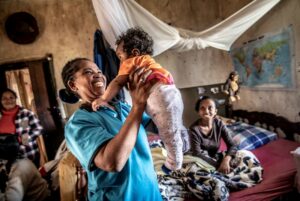
Congenital heart disease (CHD) is caused by congenital heart defects, the most common birth defects in the world. Recent evidence from the lobal Burden of Disease study show that CHD has climbed to be number 2 and 4 cause of infant mortality in high-middle and middle SDI countries and to number 8 and 7 cause of infant mortality in low and low-middle SDI countries. Of the 261,247 deaths CHD caused globally in 2017, 180,624 were infants and 85% of deaths were in low-income countries.
Children’s HeartLink is dedicated to supporting and developing sustainable pediatric cardiac programs to prevent and treat children’s heart disease in underserved areas of the world. We are a global leader in improving access to pediatric cardiac care. We partner with hospitals in 5 countries to help them develop their multidisciplinary pediatric cardiac programs and work to train their teams so they can be serving more children with improved surgical outcomes. Our model of phased support builds on the capacities of the local health system. We take a systems approach because we know that caring for children with heart disease doesn’t occur just in the operating room. Each support phase of our partnership model is tailored to the needs of the partner hospital and includes mentoring in clinical capacity, organizational capacity, training education, and patient-centered care. After 6-10 years of partnership, when a hospital consistently delivers high-quality, complex care, with evidence of stability and sustainable outcomes, it is designated a Children’s HeartLink Center of Excellence and becomes a regional training center.
We also partner with governments to help them develop a referral system for congenital heart disease and plan for pediatric cardiac services through a population health lens. This strategy seeks to influence the barriers impeding access to health care for children and ultimately ensure that high-quality care is accessible to all children in need. Barriers include: late diagnosis and late referral to heart specialists, inaccessible and costly transportation to hospitals, high treatment costs, and a limited understanding of congenital heart disease from policymakers and health systems planners.
Finally, we advocate on the global and national levels to assure better awareness of the problem and inclusion of children with heart diseases in health policies and commitment by supporting research and publications that contribute to policy and decision making of stakeholders, and development and dissemination of global and national advocacy materials, and providing expert opinion in a variety of public health, child health and NCDs in children and surgical groups. Children’s HeartLink advocacy efforts focus on creating change in four priority areas outlined in The Invisible Child series:
- Increasing the pediatric cardiac capacity
- Building the pediatric cardiac workforce
- Closing the data gap
- Financing pediatric cardiac care
Today Children’s HeartLink works with 18 hospitals in 5 countries, partners with two governments on developing population health programs and is an active participants in many global health working groups and forums.
